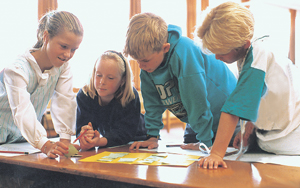![]() GENDER
COMPOSITION OF GROUPS: STUDENTS’ EXPERIENCES
GENDER
COMPOSITION OF GROUPS: STUDENTS’ EXPERIENCES
![]()
Grace
Grima
This
study evaluated the extent to which groups with different gender
compositions provided Year 4 and Year 8 boys and girls with a
similarly productive and enjoyable experience during their engagement
with one NEMP task from three different curriculum areas (language,
science, technology). |
| There were five types of gender group, each of four members: four boys (4b), three boys, one girl (3b1g), two boys, two girls (2b2g), one boy, three girls (1b3g), and four girls (4g). The video analyses focused on the dependent variables of individual participation, group interaction, co-operation and conflict, and also group products. The independent variables were the five gender groupings, the two year levels and the three task types. A questionnaire was used to ask all the children how they felt about working in their group, and an interview was conducted with a small number to gain further insight into their perspectives on group work. |  |
| •
No group type exhibited consistently higher participation levels across
the three tasks. There was no indication that girls were disadvantaged
or that boys dominated in the mixed gender groups. • Especially at Year 4, the minority student in the 3b1g and the 1b3g groups tended to participate less than the others in their group and/or to participate less than their same-gender peers in the other group compositions. However, the minority student tended to become highly involved in organising the group task. • The students’ levels of interaction, co-operation and conflict were relatively similar across the five types of groups. |
•
Achievement in the different groups appeared at times to be influenced
by subject area, task content and age group. There was no discernible
pattern between group achievement and interaction, co-operation and
conflict. • Boys and girls, at both ages, least liked the group placement where they were outnumbered. However, at Year 4, both boys and girls enjoyed working in same gender groups the most. At Year 8, boys and girls responded equally favourably to same gender and mixed gender groups with equal numbers of boys and girls. At both ages, girls were more positive than boys about working in the 2b2g groups. |
![]()
| •
When children work together in a group on a task, the task goal may
override and reduce the salience of the group’s gender composition.
Also, individual differences between children may be more important
than gender in determining children’s participation in group
work. • The ongoing claim that girls are disadvantaged in mixed gender groups needs to be questioned. Equal numbers of boys and girls in a group do not necessarily result in an equitable experience, nor does this structure protect group members from becoming sidelined in the activity. Furthermore, children’s experiences in same gender groups are not necessarily more equitable or productive than in mixed gender groups. |
• Although group gender composition seems to have little effect on children’s behaviour and achievement in small groups, the questionnaire and interview data showed that many children at both age levels perceived the outnumbered student in a gender-imbalanced group to be disadvantaged. While teachers are advised to use such placements, these need to be complemented with experiences in other settings in which children initially feel more comfortable. Teachers also need to ensure that children have opportunities to develop positive attitudes towards all forms of group work and the necessary skills to function effectively in different group situations. |